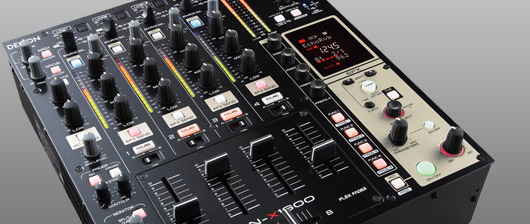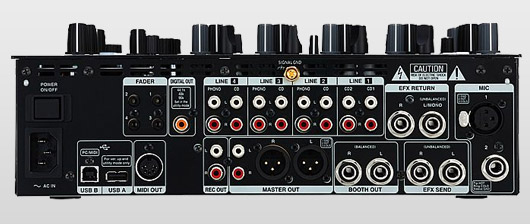Denon DN-X1600 Digital DJ Mixer review
This week Juno Plus gets under the hood of Denon’s new DN-X1600 digital DJ mixer, and finds out how it compares to Pioneer’s industry standard versions.
At first glance, Denon’s DN-X1600 mixer looks pretty much like most other four-channel DJ mixers. But, with 14 on-board effects, a USB 2.0 audio interface, full MIDI mapability as well as being the world’s first DJ mixer to feature V-Link (allowing simultaneous integration of audio and video control over MIDI using an Edirol V-4 or V-8), the DN-X1600 is definitely worth a closer inspection.
Giving the DN-X1600 the once over, it’s clear that it was made with the professional in mind. Housed in an all-metal casing, the DN-X1600 feels very solid and sturdy, and has a nice reassuring weight to it. The layout feels spacious and uncluttered, and all the controls feel sensibly positioned, with everything where you’d expect it to be. Navigating around the mixer is logical, with all the controls clearly defined by white line markings on the faceplate. The effects and MIDI controls of the mixer are easy to distinguish at a glance as these are clearly marked out in beige coloured boxes or lines. All the knobs and faders feel smooth when moved, and most of the knobs have a rubberized texture to them for a nice grippy feel. The buttons are either plastic or rubber and are mostly backlit, which is great for use in darkened environments.
“Overall the Denon DN-X1600 mixer is a fantastic mixer that equals if not exceeds Pioneer’s DJM-700 and DJM-800 mixers. Unfortunately for Denon, many DJs will strictly only use or buy Pioneer mixers because they are industry standard”
The crossfader feels very solid and smooth, like that of a pro scratch mixer, but for those who prefer a stiffer fader, the sliding torque can be adjusted (by removing a small rubber cap on the front panel and turning a screw). Metering on the DN-X1600 comes in the form of a 16-point LED, which gives clear and detailed information at a glance. The input assignment on the DN-X1600 is in the form of a matrix, which essentially means instead of inputs being permanently married to particular channels, they can be configured and switched to any of the four channels available. This would be incredibly useful if one of the channels stopped working as you’d be able to quickly flip the input to another working channel without the need for getting to the back of the mixer to unplug it. The matrix input assignment would also be perfect for DJs who like to have their setup a certain way but don’t want to unplug the inputs to do so. For example, if the CD decks are assigned to channels 1 and 4 but you like to have them on channels 1 and 2, just flipping the relevant ‘Source Select’ switches would remedy this in seconds without the need to unplug the CD decks from the back of the mixer.
In terms of inputs and outputs, The DN-X1600 has five CD/line inputs and three phono inputs on RCA connectors, two USB connections (one for connecting to a computer and another for connecting a USB storage device for saving user presets and upgrading the mixers firmware), a MIDI output (5 pin DIN), a digital output, an EFX send and return (¼ inch jack), a booth output (balanced ¼ inch jack), a master output (balanced XLR and unbalanced RCA), a REC output (RCA), 2 MIC inputs (XLR and ¼ inch jack) and four fader output terminals.
“In use, the DN-X1600 is incredibly intuitive, partly because of its simplistic layout and partly because of it’s similarity to most other 4-channel mixers. The sound is crisp and clear with warm sounding EQs”
In use, the DN-X1600 is incredibly intuitive, partly because of its simplistic layout and partly because of it’s similarity to most other 4-channel mixers. The sound is crisp and clear with warm sounding EQ’s which feature 100% kill when the knobs are turned fully anti-clockwise. The EFX section features 14 different effects which are mostly useful; however, without separate controls for the cut-off frequency and resonance, the filter effect isn’t as useable as it could be. Another issue is that the effects are all linked and controlled by the BPM (beats per minute) of the track playing, which is fine for delays and other effects which work best according to that, but for performing a simple manual low pass filter sweep, the BPM is irrelevant. Aside from that, all other aspects of the EFX section are fantastic – a nice big screen, a logical layout and a crisp pristine sound. An external effects unit can also be connected and assigned to a channel or the master as with the internal effects. This would be great for DJ’s who have a Korg Kaoss pad or something similar to add to their sets.
Connecting the DN-X1600 to a computer via the USB socket on the back panel brings a whole load of other features to the table. After installing the relevant drivers from the included CD, the DN-X1600 will function as a 4-in/4-out audio interface. This is great for archiving your vinyl collection to digital music files (MP3, WAV, or AIFF), recording your DJ mixes straight out of the mixer or playing music from your computer to the mixer. Doing a few recordings from vinyl revealed that the DN-X1600 does an incredibly good job as an interface. The recordings were crisp and clean with a warm neutral sound to them. This I’m sure is due to the high quality 24 bit/96kHz bit rate and the high signal to noise ratio phono pre-amps that Denon have used.
The DN-X1600 also functions as a fully mappable MIDI controller for use with any software that supports MIDI over USB. The MIDI functionality of the DN-X1600 definitely opens up the mixers appeal to a wider audience and makes it extremely good value for money.
“Connecting the DN-X1600 to a computer via the USB socket on the back panel brings a whole load of other features to the table”
Native Instruments Traktor Scratch is supported by the DN-X1600 and mappings for the controls are available from the Denon DJ forum. Using the DN-X1600 to DJ with Traktor was fairly straightforward and intuitive. Traktor responded well to the DN-X1600’s controls and re-mapping the controls to my taste using Traktor’s MIDI learn function was a breeze. Other features of the DN-X1600 include DVS (Digital Vinyl System) compatibility, internal 32-bit floating DSP processing and a 32-Bit DAC Output, a fader contour control for the channels and crossfader, a crossfader assignment function (A, B, Thru), an extensive utility menu to customize user settings and fader start (channel and crossfader).
Overall the Denon DN-X1600 mixer is a fantastic mixer that equals if not exceeds Pioneer’s DJM-700 and DJM-800 mixers. Unfortunately for Denon, many DJs will strictly only use or buy Pioneer mixers because they are industry standard and not because they are necessarily the best. Having used many different Pioneer mixers in clubs, I actually prefer the DN-X1600 as I feel it offers much better value for money.
Review: Ben Daly


